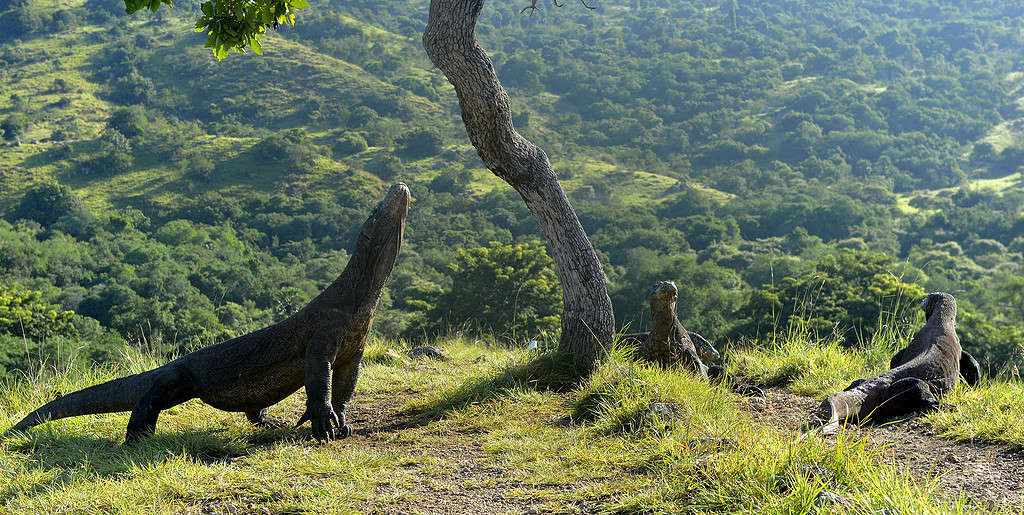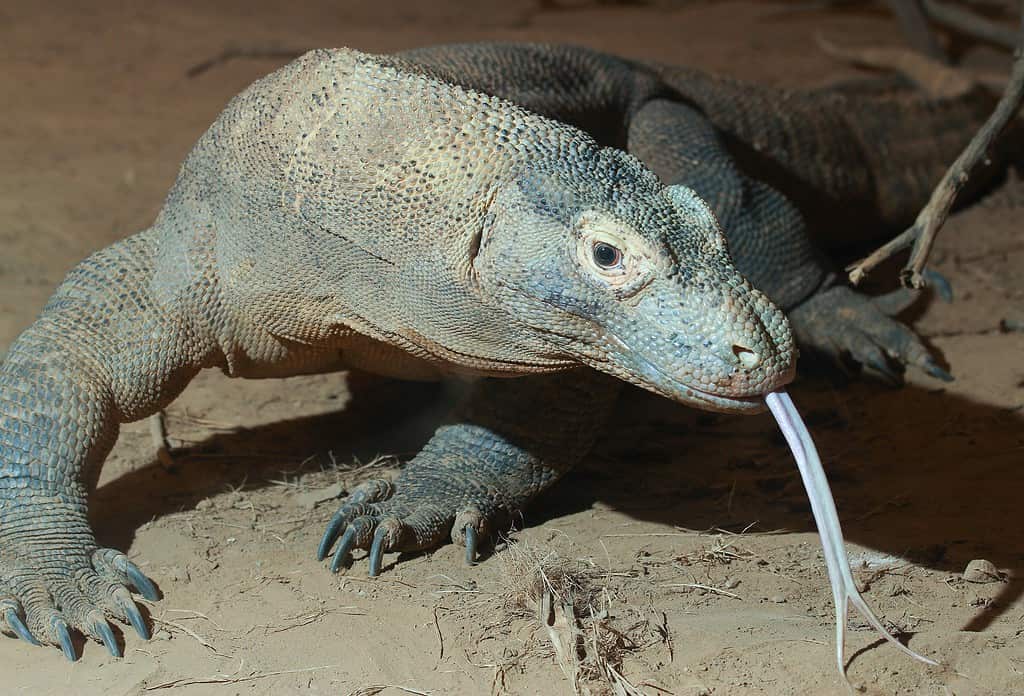The most fearsome of the reptiles is known for its poisonous bite and bursts of speed but can Komodo dragons swim? Let’s take a closer look at what makes this creature so deadly and so special.
Can Komodo Dragons Swim?
Komodo dragons can swim very well like most other monitor lizards. They dive and swim to escape enemies by folding their limbs against their bodies to make themselves more streamlined. Their tail provides the power to propel themselves forward. We know that they can swim at least a quarter of a mile between islands.
Interestingly, even though the Komodos are perfectly capable of swimming to other islands, most stay in the valley where they were born. This is probably because swimming in the open ocean is risky in part due to the strong currents. They don’t know where they will end up! Even though they occasionally eat fish, this is usually done on the shore rather than out at sea.
Can Komodo Dragons Run?

Komodo Dragons are relentless hunters.
©Sergey Uryadnikov/Shutterstock.com
These guys can certainly run but prefer to do it in short bursts. When they walk they swing their body, head, and tail from side to side in a confident swagger! The scientific name for this is an undulatory walk and they do it to detect the scent of prey from all directions as they move along. However, when running, they hold their body rigid and swing out their hind feet in a wide arc – it can look quite comical but it is effective. Komodos can walk at around 3 miles an hour but run at up to 11 miles an hour or even faster. That said, they can only run for short distances – they are sprinters, not marathon runners!
8 Fascinating Facts About Komodo Dragons
Most people find Komodo dragons both fascinating and frightening. There are plenty of myths and half-truths circulating about them. They are a type of monitor lizard in the Varanus genus and their scientific name is Varanus komodoensis. Here are 8 fascinating facts about these remarkable creatures.
1. Baby Komodos Can Climb Trees
You don’t see Komodos in trees very often, they are a bit large and their limbs are not built for climbing. However, hatchlings and juveniles can climb – probably to keep themselves safe from enemies. Some can even jump from branch to branch!
2. Larger Komodos Are Lazy
The larger adult Komodos can reach 10 feet in length and 300 pounds in weight. Moving such a large body around uses up a lot of energy so they tend not to bother. Whilst smaller dragons forage for their prey, the larger ones simply sit and wait for prey to come to them and then pounce!
3. They Are Cannibals
Yes, larger Komodo dragons will indeed hunt and eat smaller ones if they get a chance. They also feed on wild boar, goats, and birds to name just a few. The larger individuals kill around one large prey (such as a deer) every month and then supplement this with smaller prey.
4. Baby Komodos Roll In Poo To Stay Safe
Being a baby Komodo dragon is hazardous because your older cousins consider you to be their next meal. This is why smaller dragons avoid the company of larger ones if they can. Also, Komodo dragons do not like the smell of their own poop. So, baby dragons roll in it to deter the attention of older, hungry dragons!
5. Komodo Dragons Are Venomous
They have glands that release venom into their saliva. This allows them to kill larger and more resistant prey that would otherwise escape. What’s more, their dental hygiene is appalling! According to the Smithsonian’s National Zoo and Conservation Biology Institute, they have bits of rotten meat stuck in their teeth encouraging harmful bacteria to grow. This means that even if a prey animal escapes, they are likely to die later of a septic bite wound.
6. They Smell With Their Tongue

A Komodo dragon’s tongue is important for prey detection.
©Mark Dumont / CC BY 2.0 – License
Most of the time, Komodo dragons detect food using their sense of smell but they do not do this like we do. Instead, they have a long and yellow forked tongue. When they flick it out of their mouth it picks up tiny odor molecules. Their tongue moves the chemicals to the Jacobson’s organs which is on the roof of their mouth and ‘smells’ the odors. They can detect rotting flesh from 2.5 miles away!
7. Komodo Dragons Have A Huge Swallow
When Komodo dragons eat a meal, they are very efficient and only leave behind around 12 percent of their prey. They also eat a lot when they get a chance and completely gorge themselves. The problem is that they are not that good at slicing up their prey so they need to swallow large chunks. Their throat and neck muscles expand and their intramandibular hinge joint can open exceptionally wide so they can do this.
8. They Throw Up On Demand
Komodo dragons eat huge meals and have a stomach that expands easily to accommodate huge meals. They eat bones, hooves, and hide too! An adult dragon can consume 80 percent of their body weight in a single meal! This is a problem if they need to run away from something so they can vomit on demand to make themselves faster and more agile if they need to!
The photo featured at the top of this post is © Luca Vaime/Shutterstock.com
Thank you for reading! Have some feedback for us? Contact the AZ Animals editorial team.






